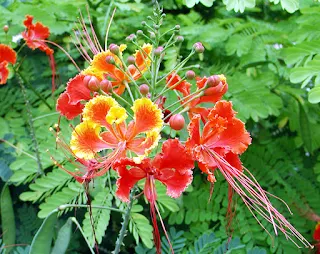By Liliana Usvat
Blog 334-365
Fiddle wood is a graceful deciduous or evergreen tree with fragrant blooms
Fiddlewood Trees (English),Citharexylum spinosum , Barrabas (Spanish), Ya'ax Niik or Yaxnik (Maya), Vitex gaumeri, Verbenaceae Family. Native to Yucatan, Mexico. "Ya'ax niik Che" (fiddlewood trees) grow wild in Mayan dry forests. Blooms clusters of small blue flowers in April and May; its fruit has green skin when ripe with one large seed. Palmately elliptic leaflets; thick grayish trunk over cut for its valuable lumber, now endangered. Since ancient times Maya J-Men Healers use its leafs in traditional healings.

Family - Taxodiaceae (Redwood family)
The botanical name is Citharexylum fruticosum (sith-ar-RECKS-sil-lum froo-tick-OH-sum) a name that can take us on quite a linguistic journey because “cithera” means guitar. So why is it “fiddlewood?” Almost directly translated the botanical name means “lyre wood shrubby” Put in better terms it could mean “guitar wood tree” or more directly “shubby kythera.” (KITH-ah-rah) Kythera (a lyre is kythara, kith-THA-rah) is also the Greek word from which we get “guitar” … kith-THA-rah… get-TAR…see it? Hear it? The Fiddlewood tree is also called the Guitar Tree.
The Fiddlewood can be planted in full sun to light shade in a
wide range of soil types and once established is extremely drought
tolerant. For best results, full sun is preferred as the canopy of the
Fiddlewood will become dense and flower and fruit prolifically.

Propagation is by seed. The tree is remarkably hearty and not normally subject to diseases as it matures. However, be on the lookout for moth caterpillars that have been known to make a meal on the leaves. Thankfully they rarely do any lasting damage to the tree.
METHOD OF PREPARATION: Ripe fruit edible raw, but not great. Do not eat the seeds.
Medicinal Uses

Blog 334-365
Fiddle wood is a graceful deciduous or evergreen tree with fragrant blooms
Fiddlewood Trees (English),Citharexylum spinosum , Barrabas (Spanish), Ya'ax Niik or Yaxnik (Maya), Vitex gaumeri, Verbenaceae Family. Native to Yucatan, Mexico. "Ya'ax niik Che" (fiddlewood trees) grow wild in Mayan dry forests. Blooms clusters of small blue flowers in April and May; its fruit has green skin when ripe with one large seed. Palmately elliptic leaflets; thick grayish trunk over cut for its valuable lumber, now endangered. Since ancient times Maya J-Men Healers use its leafs in traditional healings.

Family - Taxodiaceae (Redwood family)
The botanical name is Citharexylum fruticosum (sith-ar-RECKS-sil-lum froo-tick-OH-sum) a name that can take us on quite a linguistic journey because “cithera” means guitar. So why is it “fiddlewood?” Almost directly translated the botanical name means “lyre wood shrubby” Put in better terms it could mean “guitar wood tree” or more directly “shubby kythera.” (KITH-ah-rah) Kythera (a lyre is kythara, kith-THA-rah) is also the Greek word from which we get “guitar” … kith-THA-rah… get-TAR…see it? Hear it? The Fiddlewood tree is also called the Guitar Tree.
How To Grow It

Propagation is by seed. The tree is remarkably hearty and not normally subject to diseases as it matures. However, be on the lookout for moth caterpillars that have been known to make a meal on the leaves. Thankfully they rarely do any lasting damage to the tree.
METHOD OF PREPARATION: Ripe fruit edible raw, but not great. Do not eat the seeds.
Medicinal Uses

- Citharexylum spinosum treats asthma. Five or six leaves are pounded and the juice extracted and mixed with a spoon of Barbados oil.
- For a bad chest cold with phlegm, juvenile leaves are pounded in a little water to extract the juice and a teaspoon each of olive oil and castor oil or coconut oil added, swizzled well, and given to drink.
- For rheumatism, remove the thick bark of the tree, dry it, and put it in a pint of wine. Drink a small wine glass full every morning. This is to purify the blood.

































